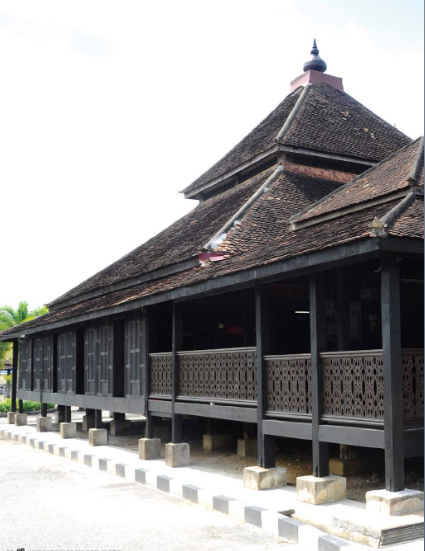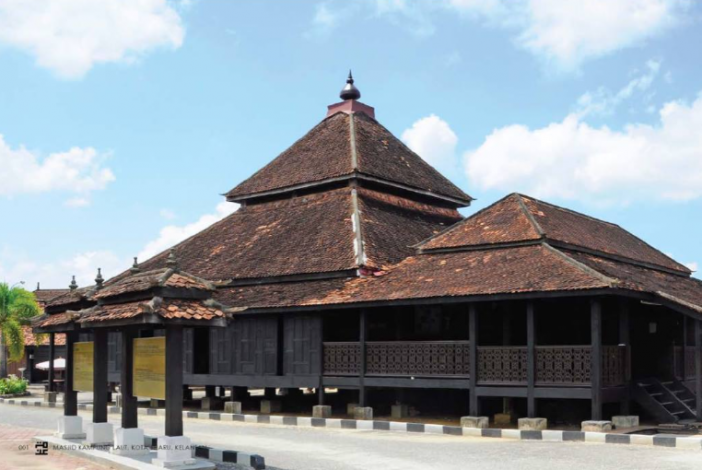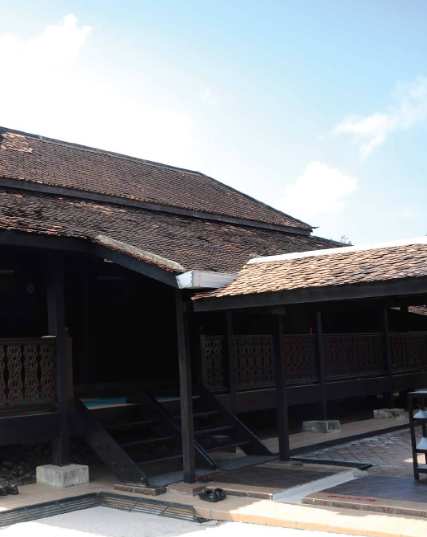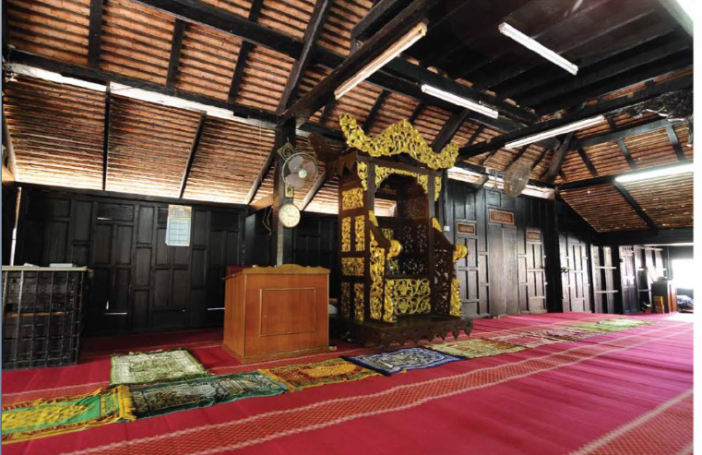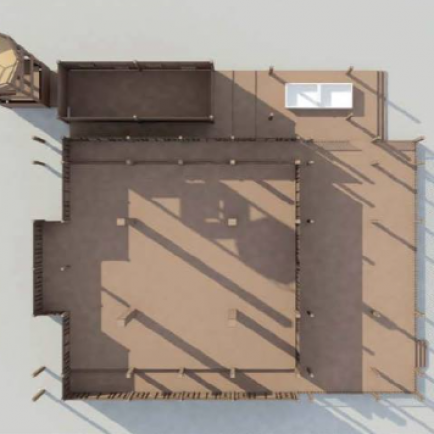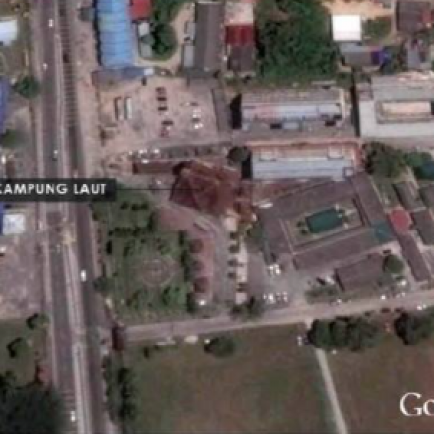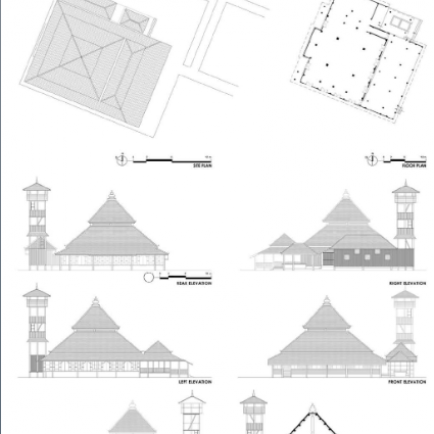Kampung Laut Mosque
History
Masjid Kampung Laut was built in the 15th century by a group of Champa government transporters; from the Kingdom of Champa. Its style is largely typical of local traditional architecture, and is climate-appropriate, similar to local houses in the area. The style is also remnant of a once culturally southern Indian Hindu architecture. The original mosque had a basic architectural style and structure: with four pillars for the foundation and palm fronds for the roof.
By virtue of architectural resemblance, it is said that the mosque was the original Masjid Agung Demak that was built in 1401. The mosque was relocated from its original site to Kampung Laut . However, there was no strong evidence to support this.
During the reign of the Sultan of Kelantan between 1859 and 1900, The mosque became an important meeting point for the Sultans and religious leaders. The mosque was also used as a trading post. During this period, the mosque was expanded and up
Urban and Architectural
This mosque is influenced by the Nusantara style. The floor plan is square in shape, The roof of lhe mosque is a three-tiered Meru roof (pyramidal roof]. The end of ridge cap is known as ekor itik in Kelantanese dialect, and it symbolises a dragon. The way the dragon is symbolized in this mosque is that it was formed into something called som that are located at the four corners of the mosque's roof. Som is divided into three parts that cre known as the head, body and tail. The shape of buah buton at the tip of the roof is the resull of refinements made in the shape of a Buddhist stupa. The uniqueness of this mosque is the existence of balai lintang (foyer hall) and waka! orang kaya (dignitary's gazebo) which were built in the 1950s by Orang Kaya Hussein, Bali lintong is located in front of the main prayer hall opposite lo the mosque's main entrance. Balai lintang was buill in 1908 at the time of Sultan Muhammad IV. The minaret, wakaf orang kaya and ablution pond are located on the right side of the main entrance of the mosque. The old minaret that had collapsed was originally located at the front of the mosque.
Description
Masjid Kampung Laut is considered to be the oldest mosque in Malaysia, built in 1676. The mosque was originally located at Kampung Laut, in Tumpat district of Kelantan about two miles (3.2 km] downstream from the town of Kola Bahru. During its construction, the mosque is believed to sit at least three-quarters of a mile (1.6 km) from the riverside of the Kelantan River and near the seashore.
Details
Location
Nilam Puri, Koto Bharv, Kelantan
Worshippers
500
Owners
Champa government transporters
Architect Name
Year of Build
1676
Area
406
Drawings
Map
History
Masjid Kampung Laut was built in the 15th century by a group of Champa government transporters; from the Kingdom of Champa. Its style is largely typical of local traditional architecture, and is climate-appropriate, similar to local houses in the area. The style is also remnant of a once culturally southern Indian Hindu architecture. The original mosque had a basic architectural style and structure: with four pillars for the foundation and palm fronds for the roof.
By virtue of architectural resemblance, it is said that the mosque was the original Masjid Agung Demak that was built in 1401. The mosque was relocated from its original site to Kampung Laut . However, there was no strong evidence to support this.
During the reign of the Sultan of Kelantan between 1859 and 1900, The mosque became an important meeting point for the Sultans and religious leaders. The mosque was also used as a trading post. During this period, the mosque was expanded and up
Urban and Architectural
This mosque is influenced by the Nusantara style. The floor plan is square in shape, The roof of lhe mosque is a three-tiered Meru roof (pyramidal roof]. The end of ridge cap is known as ekor itik in Kelantanese dialect, and it symbolises a dragon. The way the dragon is symbolized in this mosque is that it was formed into something called som that are located at the four corners of the mosque's roof. Som is divided into three parts that cre known as the head, body and tail. The shape of buah buton at the tip of the roof is the resull of refinements made in the shape of a Buddhist stupa. The uniqueness of this mosque is the existence of balai lintang (foyer hall) and waka! orang kaya (dignitary's gazebo) which were built in the 1950s by Orang Kaya Hussein, Bali lintong is located in front of the main prayer hall opposite lo the mosque's main entrance. Balai lintang was buill in 1908 at the time of Sultan Muhammad IV. The minaret, wakaf orang kaya and ablution pond are located on the right side of the main entrance of the mosque. The old minaret that had collapsed was originally located at the front of the mosque.
Description
Masjid Kampung Laut is considered to be the oldest mosque in Malaysia, built in 1676. The mosque was originally located at Kampung Laut, in Tumpat district of Kelantan about two miles (3.2 km] downstream from the town of Kola Bahru. During its construction, the mosque is believed to sit at least three-quarters of a mile (1.6 km) from the riverside of the Kelantan River and near the seashore.


